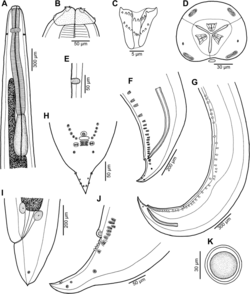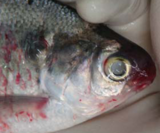Biology:Euterranova
| Euterranova | |
|---|---|

| |
| Euterranova dentiduplicata | |
| Scientific classification | |
| Kingdom: | Animalia
|
| Phylum: | |
| Class: | |
| Order: | |
| Family: | |
| Genus: | Euterranova Moravec & Justine, 2020 [1]
|
| Species | |
| |
Euterranova is a genus of parasitic nematodes that have life cycles involving elasmobranchs.[1] The genus was created in 2020 to accommodate species which were previously included inTerranova Leiper & Atkinson, 1914 [2] a taxon considered to be invalid.[1]
Etymology
The name Euterranova is composed of Terranova (the name of a nematode genus) and the prefix Eu- (= proper, true).[1] The gender is feminine.
Species
The type-species is E. dentiduplicata Moravec & Justine, 2020. It was described in 2020 from specimens from the stomach of the Zebra shark Stegostoma fasciatum, collected from off New Caledonia.
Other species are listed in the taxobox. All are parasites of elasmobranchs. An undescribed species (Euterranova sp.) was also recorded from the shark Triaenodon obesus off New Caledonia.[1]
See also
References
- ↑ Jump up to: 1.0 1.1 1.2 1.3 1.4 Moravec, František; Justine, Jean-Lou (2020). "Erection of Euterranova n. gen. and Neoterranova n. gen. (Nematoda, Anisakidae), with the description of E. dentiduplicata n. sp. and new records of two other anisakid nematodes from sharks off New Caledonia". Parasite 27: 58. doi:10.1051/parasite/2020053. ISSN 1776-1042. PMID 33186094.

- ↑ Leiper RT, Atkinson EL. 1914. Helminths of the British Antarctic Expedition, 1910–1913. Proceedings of the Zoological Society of London, pp. 222–226
Wikidata ☰ Q102826511 entry
 |



